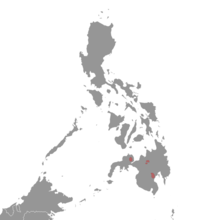Mindanao mountain rat
| Mindanao mountain rat | |
|---|---|
Conservation status | |
 Least Concern (IUCN 3.1)[1] | |
| Scientific classification | |
| Domain: | Eukaryota |
| Kingdom: | Animalia |
| Phylum: | Chordata |
| Class: | Mammalia |
| Order: | Rodentia |
| Family: | Muridae |
| Genus: | Limnomys |
| Species: | L. sibuanus |
| Binomial name | |
| Limnomys sibuanus Mearns, 1905 | |
 | |
The Mindanao mountain rat or long-tailed moss mouse (Limnomys sibuanus), is a species of rodent in the family Muridae. It is found only in the Philippines, where it is present at high altitudes in the Kitanglad Mountain Range on the island of Mindanao.
Taxonomy
Limnomys sibuanus was first described in 1905 by the American naturalist Edgar Alexander Mearns. It was based on a single individual and limited in its scope. In 1913, the biologist Ned Hollister described a second species in the genus, L. mearnsii, from a number of specimens, but this was later synonymised with L. sibuanus. Another species was described in 2003 by Eric A. Rickart as Limnomys bryophilus. The new species had a "relatively longer tail, larger hind feet, softer pelage with grayish-white ventral coloration, larger skull with a longer rostrum, larger auditory bullae, larger molars, and other [distinguishing] cranial and dental features." Both species are endemic to the Kitanglad Mountain Range in central Mindanao in the Philippines, but they differ in the elevations at which they are found.[2]
Description
The Mindanao mountain rat has a head-and-body length of 119 to 144 mm (4.69 to 5.67 in) and a tail length of 147 to 174 mm (5.79 to 6.85 in), and weighs 47 to 82 grams (1.66 to 2.89 oz). The fur is short and somewhat coarse with flattened awns. The upper parts of this rat are yellowish-brown and the underparts are plain white, with no brown on the chest. The pinnae and the hind feet are smaller than those of L. bryophilus.[2] Its karyotype has 2n = 42 and FN = 61/62.[3]
Distribution and habitat
The species is native to the Kitanglad Mountain Range in Mindanao where it occurs on Mount Apo, Mount Kitanglad and Mount Malindang. It is found at altitudes of between 2,000 and 2,800 m (6,600 and 9,200 ft).[1] Its habitat is forests composed mostly of conifers and laurels up to 10 m (33 ft) high, with fallen trees, rhododendrons, other shrubs, ferns, orchids, mosses and lichens.[2]
Status
L. sibuanus has a limited range but it is a common species in the tropical high altitude rainforest and moss forest; the whole mountain range is included in the Mount Kitanglad Range Natural Park, which was designated a protected area in 2000.[4] The habitat is not being exploited and no particular threats to this species are known, so the International Union for Conservation of Nature has assessed its conservation status as being of "least concern".[1]
References
- ^ a b c Heaney, L.; Tabaranza, B. (2016). "Limnomys sibuanus". IUCN Red List of Threatened Species. 2016: e.T11980A22429309. doi:10.2305/IUCN.UK.2016-2.RLTS.T11980A22429309.en. Retrieved 16 November 2021.
- ^ a b c Rickart, Eric A.; Heaney, Lawrence R.; Tabaranza, Blas R. Jr. (2003). "A New Species of Limnomys (Rodentia: Muridae: Murinae) from Mindanao Island, Philippines". Journal of Mammalogy. 84 (4): 1443–1455. doi:10.1644/BRP-112.
- ^ Musser, G. G.; Carleton, M. D. (2005). "Superfamily Muroidea". In Wilson, D. E.; Reeder, D. M. (eds.). Mammal Species of the World: A Taxonomic and Geographic Reference (3rd ed.). Johns Hopkins University Press. p. 1352. ISBN 978-0-8018-8221-0. OCLC 62265494.
- ^ "An act declaring the Mt. Kitanglad Range in the province of Bukidnon as a protected area and its peripheral areas as buffer zones, providing for its management and for other purposes" (PDF). Congress of the Philippines. Archived from the original (PDF) on 23 September 2015. Retrieved 17 December 2017.
- v
- t
- e
- Luzon broad-toothed rat (A. latidens)
(Bandicoot rats)
- Lesser bandicoot rat (B. bengalensis)
- Greater bandicoot rat (B. indica)
- Savile's bandicoot rat (B. savilei)
(White-toothed rats)
- Small white-toothed rat (B. berdmorei)
- Bower's white-toothed rat (B. bowersi)
- Kenneth's white-toothed rat (B. mackenziei)
- Manipur white-toothed rat (B. manipulus)
- Bagobo rat (B. bagobus)
- Camiguin forest rat (B. gamay)
- Lagre Luzon forest rat (B. luzonicus)
- Andrew's hill rat (B. andrewsi)
- Yellow-haired hill rat (B. chrysocomus)
- Heavenly hill rat (B. coelestis)
- Fraternal hill rat (B. fratrorum)
- Karoko hill rat (B. karokophilus)
- Inland hill rat (B. penitus)
- Long-headed hill rat (B. prolatus)
- Tana Toraja hill rat (B. torajae)
- Ryukyu long-tailed giant rat (D. legatus)
- Sody's tree rat (K. sodyi)
- Komodo rat (K. rintjanus)
- Gray-bellied mountain rat (L. bryophilus)
- Mindanao mountain rat (L. sibuanus)
- Bunn's short-tailed bandicoot rat (N. bunnii)
- Short-tailed bandicoot rat (N. indica)
- Ceram rat (N. ceramicus)
- Palawan soft-furred mountain rat (P. furvus)
- Flores giant rat (P. armandvillei)
- Sulawesi giant rat (P. dominator)
- Flores long-nosed rat (P. naso)
(Typical rats)
| |
| |
| |
| |
| |
|
(Giant Sunda rats)
- Annandale's rat (S. annandalei)
- Mountain giant Sunda rat (S. infraluteus)
- Bartels's rat (S. maxi)
- Müller's giant Sunda rat (S. muelleri)
- Salokko rat (T. arcuatus)
- Lovely-haired rat (T. callitrichus)
- Celebes rat (T. celebensis)
- Sulawesi montane rat (T. hamatus)
- Small-eared rat (T. microbullatus)
- Sulawesi forest rat (T. punicans)
- Tondano rat (T. taerae)
- Long-footed rat (T. apoensis)
- Spiny long-footed rat (T. echinatus)
- Kampalili moss mouse (T. orientalis)
- Luzon short-nosed rat (T. adustus)
- See also
- Aethomys–Chrotomys
- Colomys–Golunda
- Hadromys–Maxomys
- Melasmothrix–Mus
- Oenomys–Pithecheir
- Pogonomys–Pseudomys
- Stenocephalomys–Xeromys
- Otomys
- Others












